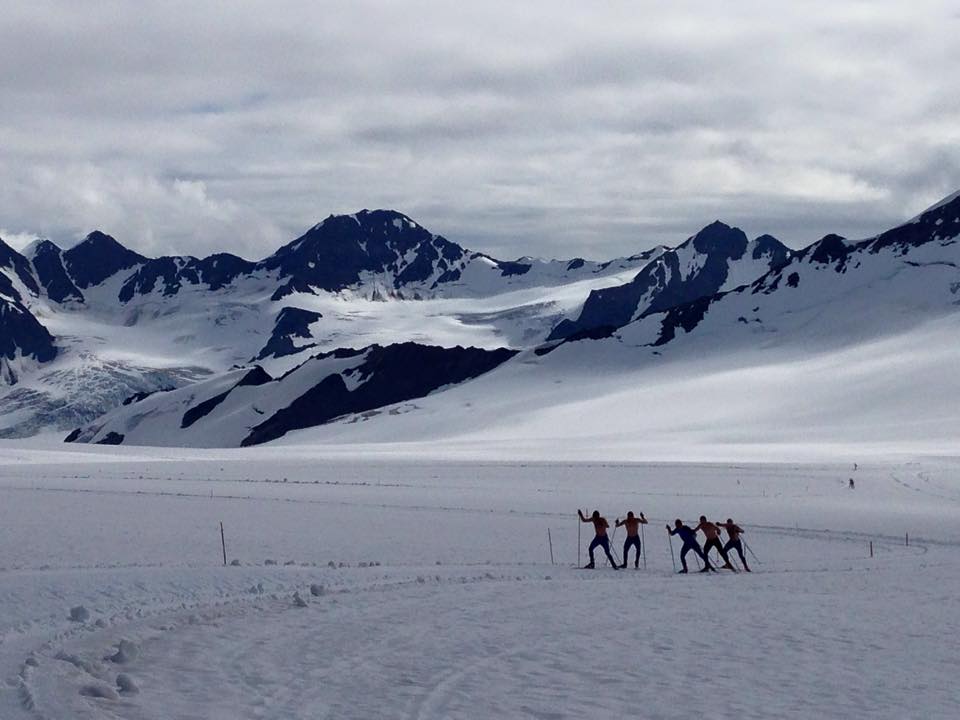
Take Preventative Action, Use Safe Glacier Travel Techniques
When glacier skiing, carry rescue equipment and know-how to use it. Building a z-pulley or rope rescue system to get someone out of a crevasse takes skill and practice.
Mountaineers routinely rope up to travel on a glacier. If appropriate glacier travel techniques are used, a deep crevasse fall can normally be prevented. However, in winter and spring, skiers access glaciated slopes for skiing, typically roping up only in heavily crevassed areas or when there is poor visibility. It is generally considered safer to ski on a glacier than to walk. Professionals from essaywriterfree.net emphasize that the weight of the skier is distributed over a larger surface area (the length of the skis) compared to a person on foot, exerting less pressure on snow bridges. Skiers also travel on glaciers in seasons when there is likely more snow cover, and they move faster.
However, this does not eliminate the need to practice safe travel techniques on glaciers at all times, paying particular caution if the area is unfamiliar. This includes always wearing a harness when glacier skiing.
This article does not provide step-by-step crevasse rescue instructions — for that, it is advised to take a ski-mountaineering instruction course to learn safe glacier travel and rescue skills. Below is an outline of the principles behind a crevasse rescue system, that can be reapplied in multiple crevasse-fall scenarios.
Crevasse Rescue Anchor
If a skier falls into a crevasse, it is often due to soft snow concealing surface evidence of the fissure and a snow bridge collapsing under the skier’s weight. As a result, a soft snow anchor is required by rescuers on the surface. The most obvious item of equipment used by skiers for a soft-snow anchor is their skis. Snowboarders can also use their snowboards.
If there is only shallow snow near the edge of the crevasse, however, ice screws may be needed to build an anchor.
Crevasse Rescue Scenario
A skiing partner has fallen six meters into a crevasse un-roped and landed on a snow bridge where the crevasse narrows. The crevasse fall casualty is conscious but has injured both shoulders such that they can’t pull out, but they think they can clip a karabiner to their harness.
Principles of a Crevasse Rescue System
Assess hazard to self.
While quick reactions are important, the experts from writemyessaycheap say it is crucial to the safety of oneself and the potential rescue of the casualty that the gravity of the situation is not compounded e.g., by the skier rushing to the edge of the crevasse.
Communicate / reassure.
Talk to the casualty; they may be within earshot even if they are not responding. Voice contact will be reassuring.
Build anchor.
This will likely use skis vertically in hard snow or buried horizontally in soft snow as a t-slot, at a safe distance from the crevasse edge. Attach a long sling to the skis and attach a rope end such that it is running at right angles to the crevasse.
Assess the situation / establish personal security.
Go to the crevasse edge ensuring personal safety (using a prussik or abseil set up on the main rope). Imagine the scenario described above. If the victim is conscious, a knotted rope end can be sent to the casualty which they can clip with a carabiner to the belay loop of their harness. If the victim is unconscious, the situation is considerably more serious and it will be necessary to abseil to them, administer first aid and attach them to the rope with the support of a chest harness.
Secure victim / load transfer.
Return to anchor. At this point, several hauling systems may be set up. To set up a z-pulley, attach an autoblock to the anchor with the rope coming from the victim threaded through this device. Bring in all the slack such that the rope is taut on the casualty ensuring they cannot fall further into the crevasse (if the snow bridge were to collapse).
Prepare crevasse edge.
A smooth ramp is needed to bring the casualty over the lip of the crevasse with a minimum of friction. This can be achieved by kicking the snow from the crevasse edge with a boot while securing to the main rope. Place poles or ice ax under rope near crevasse edge to prevent the rescue rope from cutting into the snow (creating friction).
Add mechanical advantage.
A prussik or mechanical device with a carabiner can be attached to the rescue rope (between the anchor and the casualty). The rope then bends in a z-formation giving the rescuer a mechanical advantage, making it easier to pull. This however provides only a 3:1 advantage. i.e. from writeanypapers.com, for every 3 meters, the rescuer pulls the casualty moves up one meter, sufficient for multiple rescuers. Using spare rope attached back to the anchor, and an additional prussik, more mechanical advantage can be added.
Haul.
During the hauling process, it will be necessary to reset the prussiks or mechanical devices. Ensure knees are bent and use the quadriceps as the main pulling force.
Glacier skiing can be highly rewarding for the adventurous recreational skier since it frequently offers spectacular high mountain views, sought-after cold powder snow, and oftentimes uncrowded slopes. Glaciated terrain however is usually not patrolled and hazards are unmarked. Only venture onto a glacier with good mountain awareness, appropriate equipment, and the know-how to use it.



